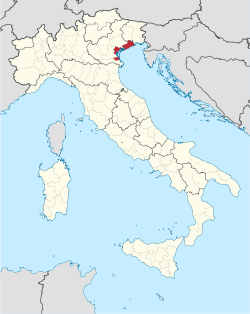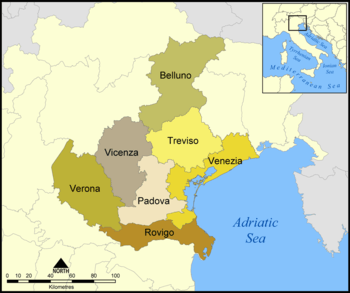Metropolitan City of Venice
| Metropolitan City of Venice | ||
|---|---|---|
| Metropolitan City | ||
 The city of Venice | ||
| ||
 Location of the Metropolitan City of Venice | ||
| Country |
| |
| Region | Veneto | |
| Established | 1 January 2015 | |
| Capital(s) | Venice | |
| Comuni | 44 | |
| Government | ||
| • Mayor | Luigi Brugnaro (I) | |
| Area | ||
| • Total | 2,467 km2 (953 sq mi) | |
| Population (2017) | ||
| • Total | 853,761 | |
| • Density | 350/km2 (900/sq mi) | |
| Time zone | UTC+1 (CET) | |
| • Summer (DST) | UTC+2 (CEST) | |
| ISTAT | 227[1] | |
| Website | Metropolitan City of Venice | |
The Metropolitan City of Venice (Italian: Città Metropolitana di Venezia) is a metropolitan city in the Veneto region, Italy. Its capital is the city of Venice. It replaced the Province of Venice and includes the city of Venice and other 43 municipalities (comuni). It was first created by the reform of local authorities (Law 142/1990) and then established by the Law 56/2014. The Metropolitan City of Venice is headed by the Metropolitan Mayor (Sindaco metropolitano) and by the Metropolitan Council (Consiglio metropolitano). Since 15 June 2015, as new mayor of the capital city, Luigi Brugnaro is the first mayor of the Metropolitan City.
History
The area was settled by 11th century BC. According to legend, Antenor fled from Troy,[2] leading the people of Eneti from Paphlagonia to inhabit the shores of the Adriatic. In 102 B.C., The Romans defeated the Cimbri and the Germanic tribes in the area, thus increasing their influence in the region to form the Regio X Venetia et Histria. The exact date when Venice was established in unknown, but about 570 refugees from the hinterland, especially from Aquileia, fled to the islands of the Venetian Lagoon in order to escape the frequent barbaric invasions. At that time, the territory of the province was part of the Byzantine Empire, belonging to the Exarchate of Ravenna.[3] Over the centuries, Venice became more independent and in 697 it had its first Doge. With the destruction of Eracliana in 805, the capital was moved to Rialto (Venice).[4]
In the Middle Ages, Venice became an important maritime republic, completely independent from Byzantium, and began its expansion into the hinterland. In 1260, the Ezzelini family were defeated.[5] Threatened by the expansionist ambitions of the Visconti of Milan, in 1365, Venice began to invade neighbouring territories. By 1410, the Regio X Venetia et Histria had annexed Padua and Verona, and by the 16th century the republic included territories from the Julian Alps to Crema, Istria, Dalmatia, Cyprus and part of the Peloponnese.[6] In 1797, Napoleon invaded the Republic and, following the Treaty of Campo Formio, it was ceded to Austria. After the final defeat of Napoleon, the Austrian Empire founded a province of Venice on the Adriatic.[6] In 2015 this was converted to the current Metropolitan City.
Geography

Facing east on the Northern Adriatic Sea,[7] the Metropolitan City is bordered to the northeast by the Province of Udine and Province of Pordenone, south by the Province of Rovigo, and to the west by the Province of Padua and Province of Treviso. The municipalities of Chioggia, Cavan and Cona constitutes an exclave separated from the rest of the Metropolitan City, bordering the provinces of Padua and Rovigo.
The Brenta and Livenza rivers flows through the former province. The Piave River flows into the Adriatic after passing the town of Eraclea. The 174 kilometres (108 mi) long Brenta runs from Trentino to the Adriatic Sea just south of the Venetian lagoon.[8] It was first channeled in the 16th century when a long canal was built from the village of Stra to the Adriatic Sea, bypassing Venetian lagoon. A branch of the Brenta, named Naviglio Brenta, was left to connect directly Venice and Padua.[9] The river runs through Stra, Fiesso d'Artico, Dolo, Mira, Oriago and Malcontenta to Fusina in the north-east.
In areas that border the Friuli Venezia Giulia Region, it is estimated that 29% of the population speaks fluent Friuli. The language is officially recognized and has been protected as a minority language since 2006.[10]
Metropolitan area
The spatial spread of the Venice metropolitan area has greatly accelerated over recent decades. The Padua-Treviso-Venice Metropolitan Area (PATREVE) or Venice City-Region, in fact, is an urban agglomeration centred on the cities of Padua, Treviso and Venice in the Veneto region of north-east Italy.[11] It is defined statistically and does not correspond to a single area of local government. Administratively it comprises the communes (municipalities) of the 3 cities plus other 240 communes (overall 104 in the province of Padua, 95 in the province of Treviso and 44 in the province of Venice).[12][13] The metropolitan area has a total population of 2,600.000.[14]
Main sights
In addition to the city of Venice, the province offers a number of other attractions including Caorle on the Adriatic Coast with its narrow streets, coloured houses and cylindrical bell tower, and Jesolo, with its long sandy beach, tourist attractions and nightlife.[15]
The second largest municipality it the province, Chioggia, on the southern side of the Venetian Lagoon, includes numerous canals, bridges and mansions as well as St. Felice Castle and the Piazza di Vigo.[16]
References
- ↑ "Codici delle città metropolitane al 1° gennaio 2017". www.istat.it (in Italian). 23 December 2016.
- ↑ Baswell, Christopher (22 June 2006). Virgil in Medieval England: Figuring The Aeneid from the Twelfth Century to Chaucer. Cambridge University Press. p. 18. ISBN 978-0-521-02708-3.
- ↑ Nicol, Donald M. (7 May 1992). Byzantium and Venice: A Study in Diplomatic and Cultural Relations. Cambridge University Press. p. 10. ISBN 978-0-521-42894-1.
- ↑ Fedalto, Giorgio (1999). Aquileia: una chiesa due patriarcati (in Italian). Città nuova. p. 196. ISBN 978-88-311-9081-7.
- ↑ Zamboni, Filippo (1870). Gli Ezzelini, Dante e gli schiavi, ossia Roma e la schiavitù personale domestica studi storici e letterari di Filippo Zamboni (in Italian). Presso il figlio di C. Gerold. p. 171.
- 1 2 "Storia". Ristorantivenezia.net. Retrieved 27 September 2014.
- ↑ Lane, Frederic Chapin (1 November 1973). Venice, A Maritime Republic. JHU Press. p. 79. ISBN 978-0-8018-1460-0.
- ↑ Colombini, Paola (1992). Veneto: (esclusa Venezia) (in Italian). Touring Editore. p. 581. ISBN 978-88-365-0441-1.
- ↑ Zimmermanns, Klaus (2009). Venetien: die Stadte und Villen der Terraferma (in German). DuMont Reiseverlag. p. 219. ISBN 978-3-7701-4356-6.
- ↑ "Provincia di Venezia" (PDF) (in Italian). Politichesociali.provincia.venezia.it. Retrieved 27 September 2014.
- ↑ Global Veneto - Information from the Veneto Regional Council Archived 2012-06-02 at the Wayback Machine.
- ↑ OECD Territorial Reviews: Venice, Italy 2010
- ↑ PaTreVe, Strategic plan of the Venice Municipality
- ↑ Ocse: Pa-Tre-Ve, a record GDP Growth - Il Mattino di Padova
- ↑ "Venice". Discover Italy. Retrieved 29 September 2014.
- ↑ "Chioggia Città d'Arte" (in Italian). Città di Chioggia. Retrieved 29 September 2014.
Coordinates: 45°26′23″N 12°19′55″E / 45.4397°N 12.3319°E

